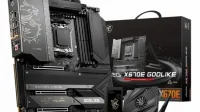Building a PC around a brand new processor was expensive at the best of times, and that’s three times as much as AMD’s new Ryzen 7000 chips. AMD started with high-end chips starting at $300, leaving mid-range options until next year. The processors only support DDR5 RAM, which is still more expensive than DDR4 for the same capacity. And the first batch of motherboards with the new AM5 CPU socket is here, and they are quite expensive.
The cheapest motherboard currently available from companies like Newegg and Micro Center is the ASRock X670E PG Lightning, which despite being the cheapest motherboard available, is an X670E board that will support PCIe 5.0 GPUs when they eventually arrive (even the recently announced GeForce RTX 4000 series still uses PCIe 4.0). The motherboard lacks some of the features we’d like to see – built-in Wi-Fi and Bluetooth, limited audio outputs, relatively small heatsinks for voltage regulator modules (VRMs) and other components – but it does have four M.2 connectors. Slots for SSDs at different speeds and plenty of headers for case fans and USB ports on the front.
If you care, the cheapest X670E Wi-Fi board is also an ASRock board, the X670E Pro RS, available for $280 at Newegg and Micro Center.

As you move up in price to the $500 mark, you start to see more of the extras that high-end boards are known for: big heatsinks for VRMs and, often, big, solid metal heatsinks that cover most of the SSD. slots and make the board look a bit cleaner inside the case with the side window. Asus ROG STRIX X670E-F ($ 450), Gigabyte X670E Aorus Master ($500), and MSI MPG X670E Carbon Wifi ($480) are in that cohort with their big bright RGB heatsinks. Compared to lower-end boards, they also have more USB-C ports on the back and a higher ratio of USB 3.x ports to USB 2.0 ports.
Fans of tiny builds will be disappointed to see that there’s only one mini-ITX AM5 board available at the moment, and it’s quite pricey: Asus ROG STRIX X670E-I Gaming Wifi ($470) looks powerful, but also a little odd, with an odd external hub called “ROG Strix Hive”and a protruding daughterboard for USB 2.0 port headers, front panel headers, and some SATA ports, which can be awkward in some particularly small ITX cases.

The “most absurdly expensive motherboard”award goes to the MSI MEG X670E Godlike, which costs $1,300, almost twice as much as the next most expensive motherboard. A hulking black monolith, this board is covered in shiny heatsinks and tries to justify its price tag, including a riser for additional PCIe 5.0 SSDs and an integrated 10Gb/s Ethernet port.
Prices won’t be this crazy forever, or even (hopefully) for a very long time. This first wave of boards leans heavily towards the more expensive X670E variant (20 boards at Newegg versus just four X670 boards), which must meet the more stringent PCI Express 5.0 signaling requirements for the graphics slot.
In October, AMD will also release the B650 and B650E boards, which use only one chipset die, while the X670 uses two – these motherboards should bring AM5 support well below $200 while still maintaining good performance. Next year, with DDR5 memory prices steadily dropping and AMD releasing more mid-range Ryzen 7000-series processors, recommending the AM5 build to buyers on a budget will become a little easier. AMD plans to support AM5 until at least 2025, so the board you buy now should be eligible for at least a few new processors in the next few years.


